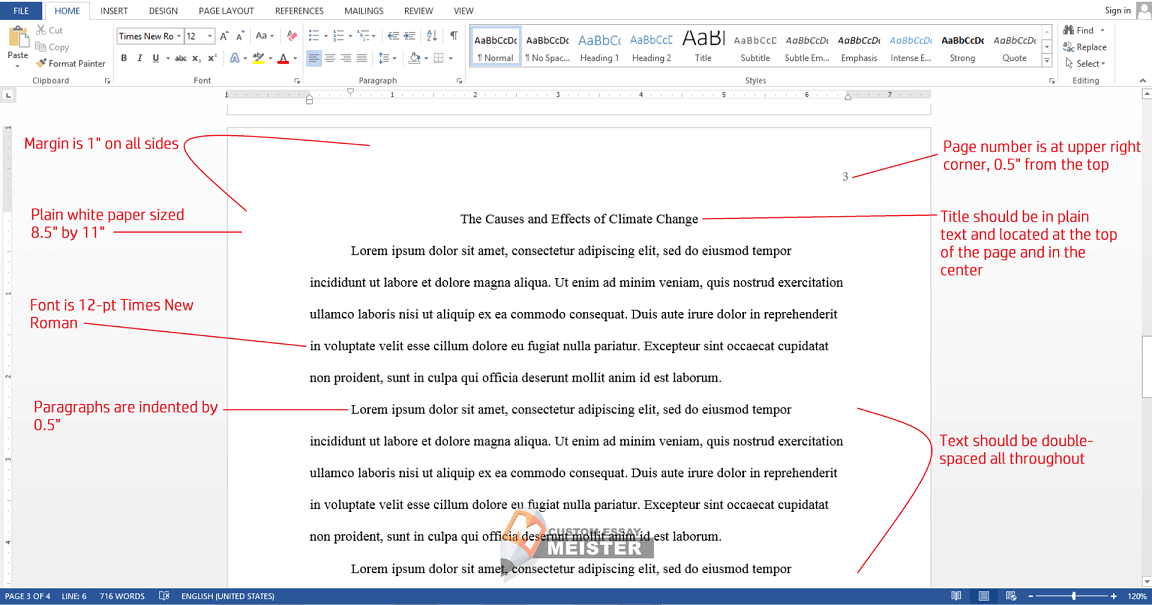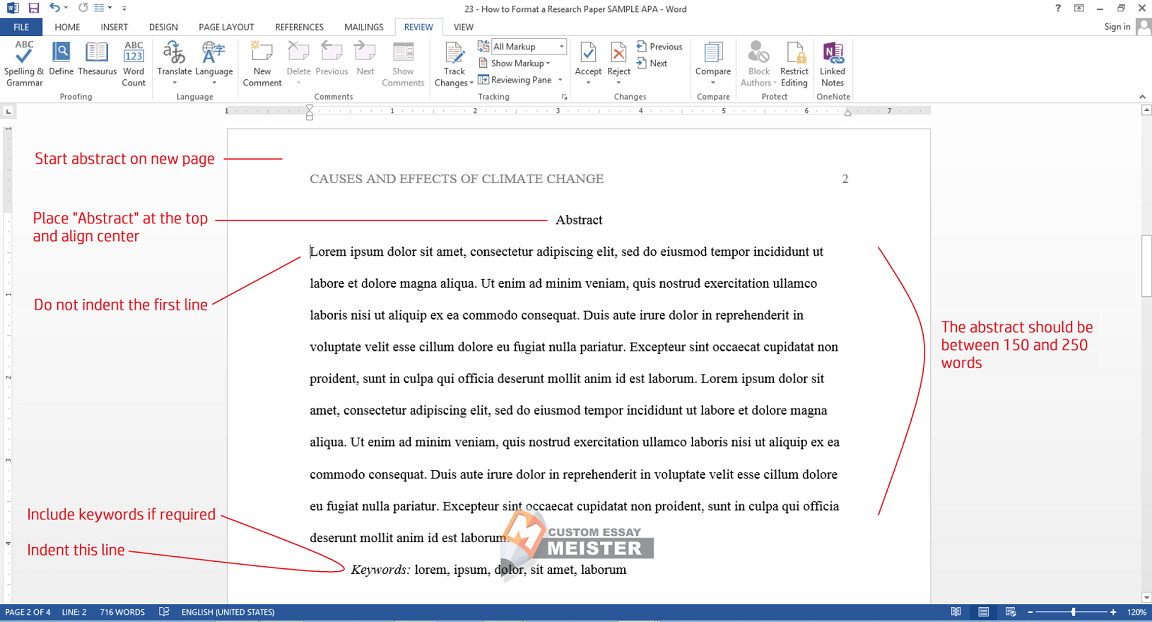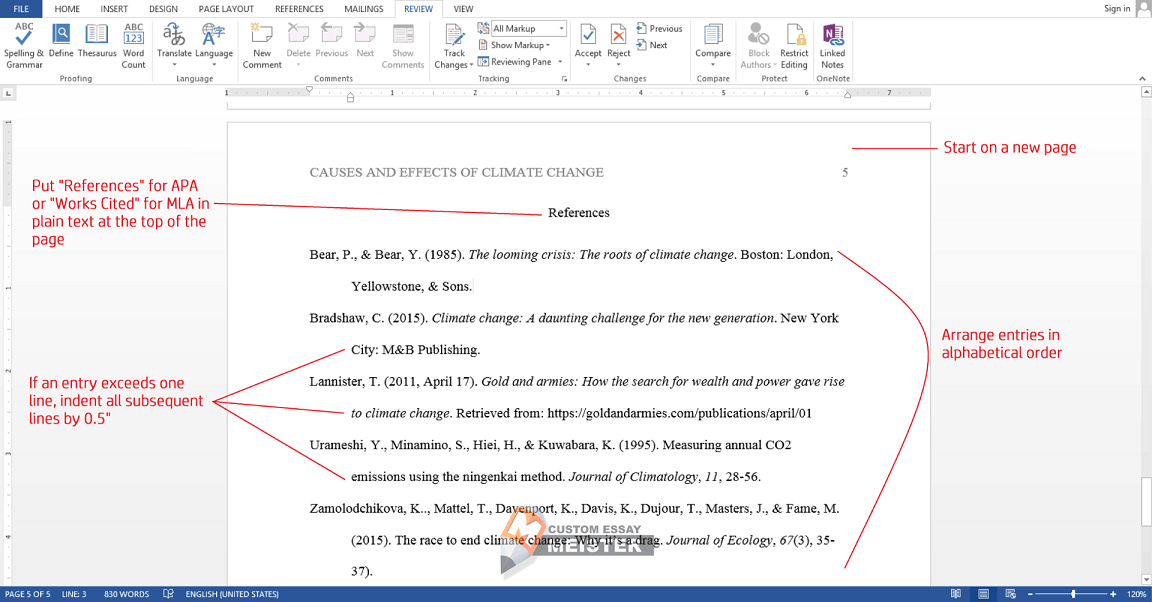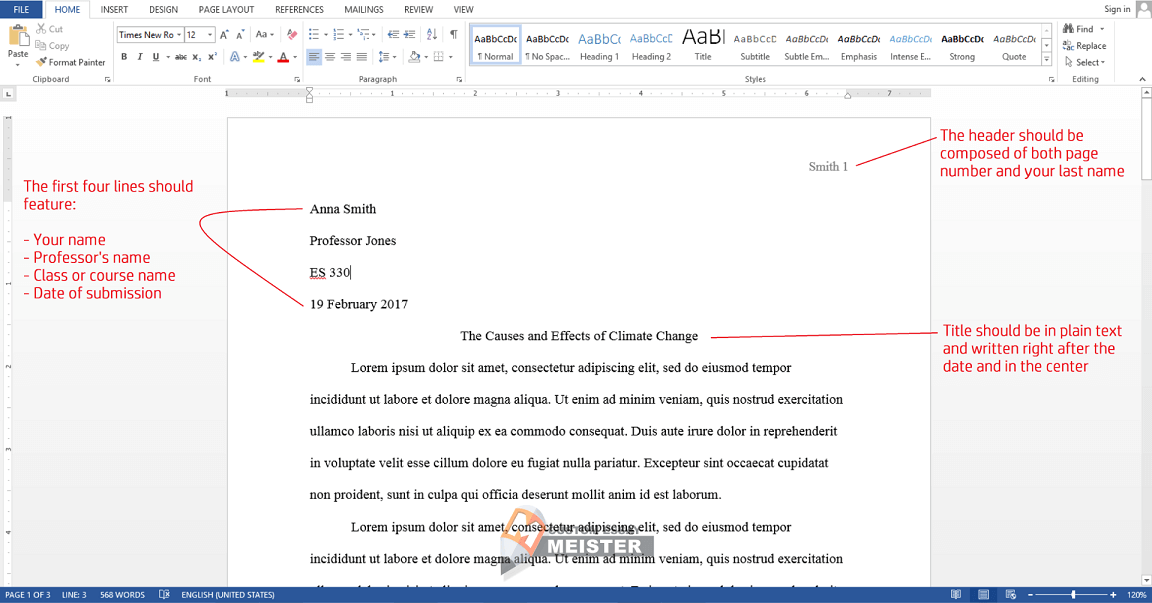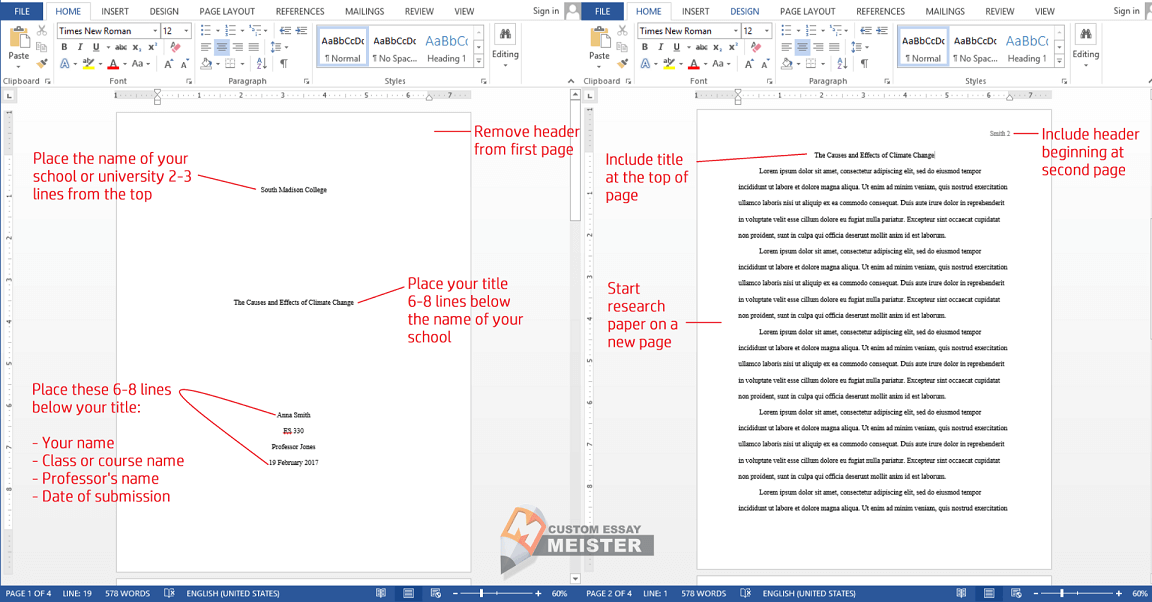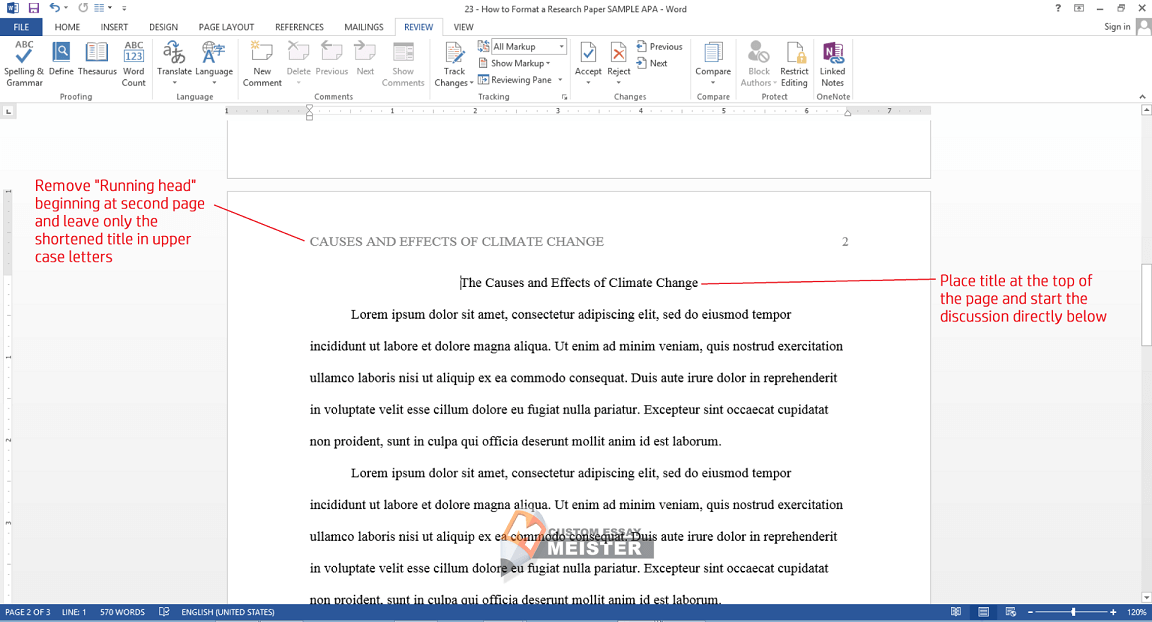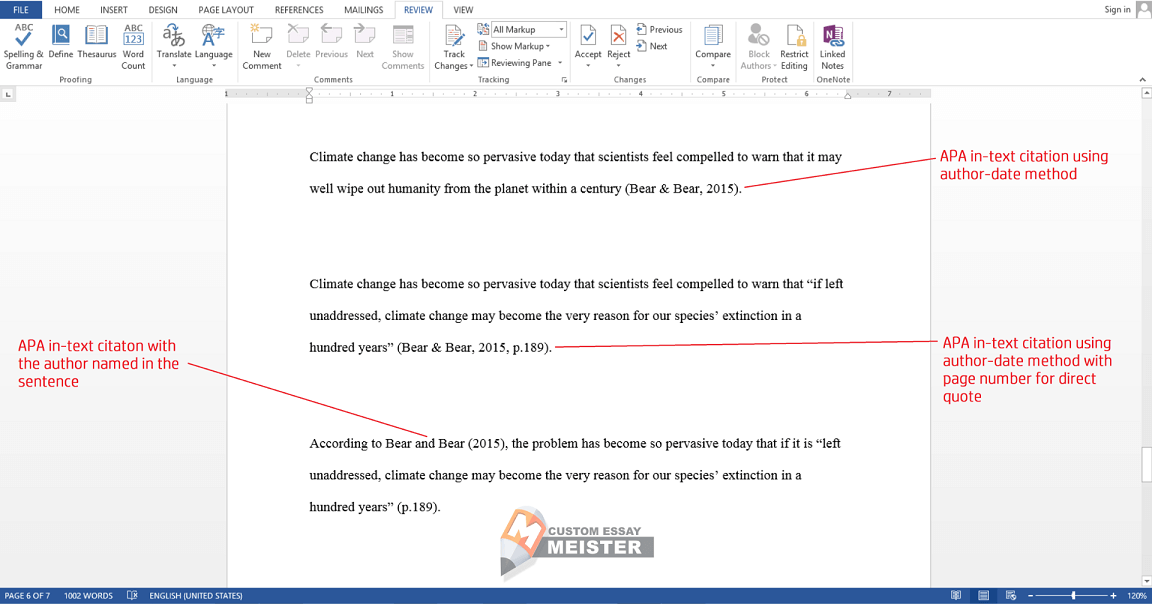How to Format A Research Paper
While the format of a research paper may be the last thing on your mind when writing, following the prescribed format is actually important. Apart from improving your paper’s structure, organization, and flow, appropriate formatting enhances the overall appearance of your output. In learning how to format a research paper, the first thing to consider is the academic style, which dictates the citation format for a research paper. There are many different styles, but for practical reasons this article focuses only on APA (American Psychological Association) and MLA (Model Language Association).
General Structure
While research papers can be about different topics, most research papers tend to follow the same fundamental structure. A research paper is usually composed of three major parts:
Introduction Formatting Structure
The first part is the introduction. As the term suggests, this section should work towards introducing the topic and content of your paper. But more than just opening your paper, your introduction should accomplish these two goals:
- First, your introduction should provide background information or context. For instance, your research paper will likely present a specific claim. But before you present this claim, you should use the introduction to explain the purpose of your paper or why the claim is being advanced.
- Second, your introduction should present your thesis statement. Your thesis is the main claim of your paper. It is the idea that serves as the anchor for all your discussion.
Main Body Formatting
The main body is where you elaborate on your thesis. This is where you present one or more of the following:
- Your findings from research
- Your analysis
- Your arguments
- Evidence
- Your rebuttals to any counterarguments
Conclusion Formatting Structure
The last part of your paper , this is where you wrap up everything that you have discussed in the previous sections. Your conclusion should not present new information. Like the introduction, it should also accomplish a number of goals:
- First, your conclusion should reiterate the thesis. This is your way of reminding your reader of the main idea you are communicating.
- Second, it should summarize the main points as a way of reviewing the reasons that support your thesis.
- Finally, you can also include final thoughts or impressions. For example, you can pose a new question for the reader to consider.
General Guidelines
Although there are significant differences between the APA research paper format and the MLA research paper format, there are also similarities between the two styles. Here are some general guidelines for an academic research paper format regardless of citation style:
- Paper Size : The standard paper used in academic writing should be white and sized 8.5” by 11”. This size is also known as “Letter”. In some cases, your professor may prefer the size known as “A4”, which is 8.27” by 11.69”.
- Margins: Set the margin to 1” on all four sides of the paper. Content should not be justified and instead flushed to the left.
- Font : While different fonts can be used, Times New Roman in 12-pt is the most often prescribed. Avoid using fonts that are difficult to read as well as those that do not look professional.
- Spacing: Double-space all your content and eliminate extra spaces between paragraphs.
- Indentation: Indent the beginning of all paragraphs by 0.5”.
- Page Number: Page numbers are indicated at the upper right corner, 0.5” from the top and flushed to the right margin.
- Title : The title should be written in plain text, placed in the center, and have all major words capitalized.
Abstract
Longer research papers sometimes require the inclusion of an abstract. An abstract is basically the summary of your entire paper. It should highlight the main ideas of your work. When reading the abstract, the reader should get a general idea of what your paper is all about. Remember, the abstract should be concise, and thus you should be careful in writing it to ensure that you are not wasting words. When including an abstract, here are some formatting guidelines to follow:
- Start on a new page.
- Place the word “Abstract” in plain text at the top of the page in the center.
- The first line of the abstract should not be indented.
- An abstract should be 150-250 words only, unless the instructions specify a different word count.
- If required, keywords can be included in another line directly below the abstract. Write the word “Keywords” in italics followed by a colon. Then list your keywords. This line should be indented by 0.5”.
References/Works Cited Page
Learning the basics of college research paper format is not complete without paying attention to the references or works cited page. A references or works cited page is a list of all the sources that you used in writing your research paper. Bear in mind that all sources with in-text citations should appear on this list. MLA and APA have different rules when it comes to citing sources. However, they also have similarities when it comes to formatting. Here are some of the general guidelines when presenting your list of sources:
- Start on a new page.
- For an APA format research paper, you should use the term “References”. Place the word in plain text at the top of the page and in the center.
- For an MLA format research paper, you should use the term “Works Cited”. Place the term in plain text at the top of the page and in the center.
- Arrange your sources in alphabetical order.
- Use double-spacing and flush the text to the left.
- If a citation entry exceeds one line, all subsequent lines should be indented by 0.5”. This format is known as hanging indentation.
Other Sections
Apart from the title or cover page, the abstract, the paper itself, and the list of sources, your research paper may include other sections. Here are some of the other common sections included in a research paper:
- Table of Contents . This refers to a list of the major sections and subsections of your paper including their page numbers. The table of contents can be formatted in different ways. Most of the time, your professor’s formatting expectations are flexible. The important thing is for it to be easy to understand, organized, and accurate. Examples of formatting can be easily searched on the internet.
- Outline . The outline is a summary of your research paper that shows how the content is organized. It is different from the abstract. Whereas the abstract conveys the main ideas of your paper, the outline shows the order in which the ideas are presented and their relationship to each other. For instance, the outline lists your thesis statement at the beginning, presents all of your arguments in concise form including the evidence that supports each of the arguments, and ends with your conclusion. The outline can be formatted in different ways, and most of the time the instructions will tell you how to format the research paper outline if required.
- Appendices . Appendices refer to supplementary materials that you used in completing your research paper. For instance, if a document you consulted is important for understanding your paper but is too long to quote in your paper, you may include a copy of it at the end of the paper. Appendices are arranged by the order in which they are referred to in your research paper and are referred to by letter, e.g. Appendix A, Appendix B, Appendix C, etc.
Differences Between MLA and APA Formatting
As stated earlier, MLA and APA styles have differences despite sharing basic formatting guidelines. In this section, we look at some of the basic differences between the two and discuss how each should appear.
When to use MLA or APA?
You may wonder, how do I know which style to choose when formatting a research paper? Most professors will tell you which style to use, which saves you the trouble of figuring it out. But there are times when you will need to determine which style fits your research paper. Here’s a quick guide:
Using MLA
Modern Language Association or MLA is mostly used in the arts and the humanities. This means that classes in literature, fine arts and performing arts, history, philosophy, religion, politics, and languages among others usually require the use of the MLA style.
Using APA
The American Psychological Association or APA, is mostly used for psychology, education, business, social sciences, and natural and life sciences. Examples of classes that usually require APA are those in economics, leadership and management, chemistry, engineering, and healthcare among many others.
Note that there is some overlapping between topics that require MLA and topics that require APA, especially for the social sciences. If you are unsure which to use, ask your professor for guidance.
MLA Style
One of the differences between MLA and APA is the format of the first page. Papers in MLA style often do not require title pages. Instead, the content begins at exactly the first page. An MLA paper will include a title page if the instructions explicitly ask for it or if other sections are featured before the actual body itself. Here are the guidelines for applying the research paper format for MLA:
- Heading: The first four lines of the paper should feature the following in plain text and flushed to the left.
- Your name
- The professor or instructor’s name
- The class
- The date of submission
- Title : The title should be written in plain text, placed in the center in the line after the date, and have all major words capitalized.
- Header and Page Number : The line where your page number appears should be considered as your running head or header. Write your last name beside the page number in plain text and flushed to the right.
-
Title Page: If you do include a title page, you should remove the header on the first page and instead write the following:
- Your university or school’s name in plain text 2-3 lines from the top of the page and in the center.
- The title of your research paper about 6-8 lines below your university or school’s name.
- Your name, class, professor’s name, and date of submission in consecutive lines about 6-8 lines below your title.
If your paper has a title page, you should start your actual research paper on a new page. Write the title at the top and in the center, and begin your paper in the line directly below the title. Include the header composed of your page number and your last name this time. As for the list of sources, write the term “Works Cited” in plain text at the top of the page and in the center.
A sample of the first page for MLA:
A sample of the title page for MLA:
APA Style
The APA format is different when it comes to the title page. Unlike in MLA, an APA paper often requires a title page. There are also other details to follow when formatting the paper. These are the basic guidelines when applying the APA format:
-
Title Page: The title page should include the following:
- The full title of the research paper in plain text should be placed in the center of the page, around 7-9 lines from the top.
- Write your full name directly below your title.
- Write your university or school’s name directly below your name.
- Running Head: The running head is placed on the same line where your page number appears. For the first page, write the term “Running head” in plain text and flushed to the left. Then follow this with a colon and the shortened version of your paper’s title in upper case letters. Remember, the running head should not exceed 50 characters including spaces. Beginning at the second page and beyond, remove the term “Running head” and leave only the shortened title in upper case letters. After the title page and any other sections that come before the body of your paper, start your actual research paper on a new page. Write the title at the top and in the center, and use begin your paper in the next line.
See an example of an APA title page below.
In-Text Citations
Still part of formatting are the in-text citations that you will include in the body of your paper. An in-text citation is basically a short citation that states the source of the information you present. In-text citations are important elements in a paper. They serve two purposes: first, it tells the reader which source you used and, second, it helps you avoid committing plagiarism by crediting your source.
Now, in-text citations can be quite complicated because of the many types of sources that you will use. Besides, there are different ways to write an in-text citation depending on the situation. However, both MLA and APA have basic rules that you need to remember.
MLA Basic Rule
MLA follows the author-page method. This means that your in-text citations should feature both the last name of your author and the page number enclosed in parentheses. So whether you paraphrase, summarize, or directly quote information, you will include the name of your source’s author and the page number where the information is located. If you already name the author in the sentence, you do not need to include the name inside of the parentheses. See the examples of how these should appear below:
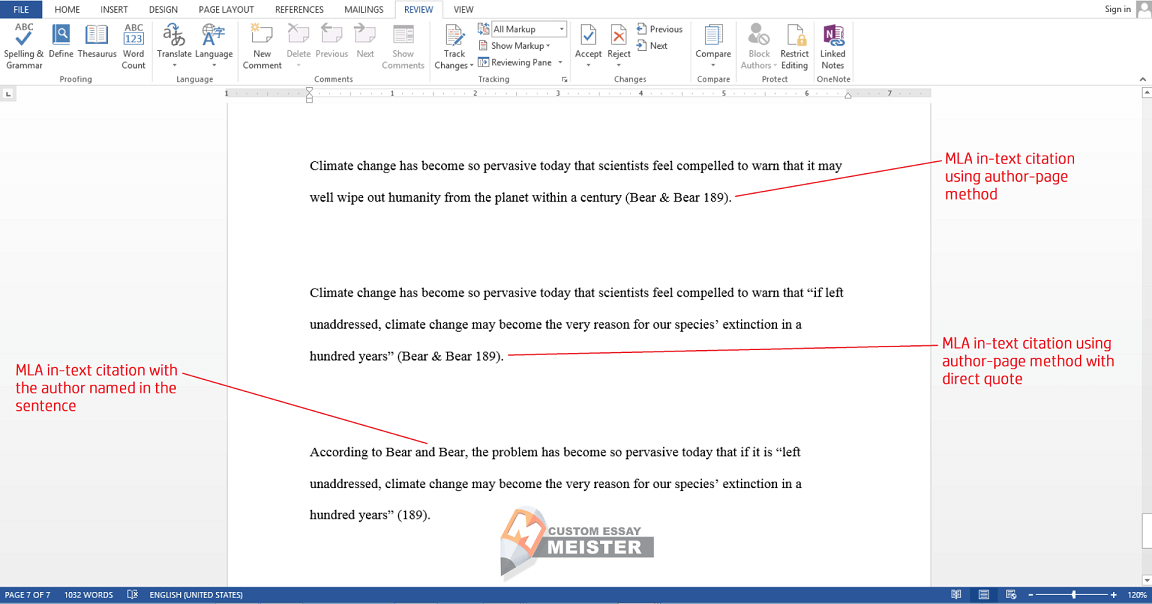
APA Basic Rule
A research paper in APA format, on the other hand, follows the author-date method. This means that instead of the page number you will present the name of the author and the year the source was published separated by a comma. However, note that a page number can also be included if you are including a direct quote. Again, if you already name the author in the sentence, you do not need to include the name inside the parentheses. See the examples below:
Conclusion
While there are general guidelines regarding the proper format of papers, the exact format of research papers may still vary. For instance, some professors may ask you to make specific changes. Therefore, it is important for you to read instructions carefully in order to follow your project’s formatting requirements, especially if your professor is strict when it comes to this. That said, following these guidelines on how to format a research paper is an excellent start to ensuring that your paper is properly formatted.
Essay and Research Paper Service for College Students
The process of writing a research paper does not stop at presenting a well-written discussion. The format is also part of the criteria. Now, if you are able to provide quality work in correct formatting, then there is no reason for you not to get that A.
But while learning how to write and format a paper can help you get good grades, a looming deadline can be a source of anxiety for a busy student like you. Between studying, your personal life, and other activities, it's likely that you won't have enough energy to craft an excellent research paper. This is when you can count on CustomEssayMeister for help. Seeking help when it comes to writing your papers is the way to go, especially when your academic responsibilities are piling up. We specialize in custom written papers written according to clients' personal specifications and standards. Custom papers mean all-original papers: custom essays, custom research papers, custom term papers, custom presentations mean. They are all topnotch quality papers written from scratch, crafted for unique clients, and meant to be their personal property for life. Whether it's the research paper you are struggling with or formatting, CustomEssayMeister is your ally. We sincerely want to help busy college students like you realize your potential because, truth is, college is not just essay and academic writing; it is a chapter that will shape your future. Contact us for inquiries and if you have concerns before you place your order.
